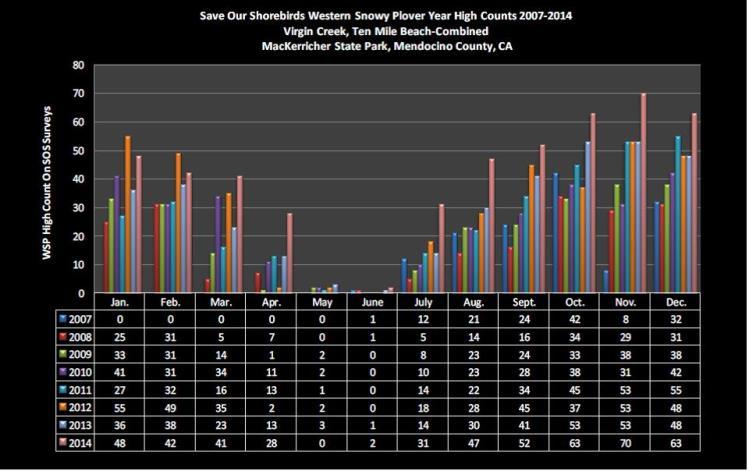Snowy Plovers, like many shorebirds, have been impacted by development, non-native vegetation, predators attracted by trash and disturbance by humans. The estimated Snowy Plover population along the Pacific Coast is around 2,500, making every breeding and wintering spot important to the survival of the species. The winter flock of Snowy Plovers in Inglenook Fen - Ten Mile Dunes Natural Preserve in MacKerricher State Park in Mendocino has been 50 or more in the past few years—making this area a preserve that is recognized as part of an Important Bird Area by National Audubon. Additionally, Snowy Plovers have attempted to nest on Ten Mile. According to the US Fish and Wildlife Service, only 28 Snowy Plover nesting areas remain.
Restoration work planned for Ten Mile Beach included removal of 2.7 miles of an old logging haul road, two culverts and hand-pulling of European beach grass. Snowy Plovers were being squeezed between rising ocean levels, a solid wall of European beach grass and the haul road.
A large team of partners, led by senior environmental scientist Renee Pasquinelli at the Mendocino District of the California State Parks, worked together to implement the project and garner support. Mendocino Coast Audubon, California Native Plant Society, Sierra Club, Audubon California and California State Parks educated the public about the project and encouraged supporters to speak at public hearings and write letters to county supervisors and Coastal Commission staff. Mendocino Coast Audubon’s Conservation Chair, Linda Perkins, worked tirelessly to create flyers and provide scientific data to successfully advocate for approval of the project.
Audubon California rallied our members to support the project, and one action alert resulted in a flood of emails that temporarily overloaded the county internet system. One county supervisor remarked "when we vote on this issue, we are being watched by a lot of people."
Although the Mendocino Board of Supervisors (3-2 vote) approved the project in the summer of 2013, opponents appealed to the Coastal Commission. On November 13, 2013, the California Coastal Commission approved the project after finding no substantial issue in the appeal.

The cost of this project was originally set at $725,000, then augmented with an additional $150,000 due to the lengthy permitting process. It was fully funded with ear-marked Prop 84 funds. The major part of the restoration was finished in the winter of 2014 when the 2.7-mile long Haul Road was removed and recycled by State Parks contracted personnel. After the road was removed, volunteer surveyors noticed that native plants popped up all over the restored area. The road removal, plus the removal by hand of non-native invasive European beach grass has restored and improved an estimated 250 acres of new nesting area for Western Snowy Plovers.
This project is ongoing with the continued removal of European beach grass. Mendocino Coast Audubon member Becky Bowen has already seen the results of the restoration, “It has opened up a new world to our Snowy Plovers.”

The number of Snowy Plovers using Ten Mile Beach has increased, and three nests were found this breeding season. While they unfortunately failed, volunteers were happy to see these pioneers breeding in small numbers. Becky reports that there were no nests seen at Ten Mile Beach from 2004 until 2013, “Snowy plovers leave Ten Mile to breed and raise chicks elsewhere. The nests seen in 2015 are tremendous progress for these birds. We have high hopes.”
The plovers that are at Ten Mile Beach now are taking refuge and using the gently rolling foredunes along the beach--something they were not able to do while non-native beach grass was present. Volunteers have also noticed an increase in the number of birds returning at the end of the breeding season.
One bird that Becky is hoping to see soon is nicknamed Orro because of her band colors (OR:RO). This plover has been coming back to winter at Ten Mile every year since 2007. She fledged at Moss Landing in 2007, and has returned to that general area during breeding season every year. But Ten Mile is where she spends her winters. We hope that Orro will join the other Snowy Plovers who have found shelter and new acres of habitat designed with their needs in mind at Ten Mile Beach.
All photos and graph courtesy of Becky Bowen, Mendocino Coast Audubon Society
By Ariana Rickard
A New Colony of Caspian Tern Decoys on Aramburu Island
Richardson Bay Audubon Center is attacting breeding pairs of Caspian Terns with these newly painted tern decoys—a strategy successfully used by previous tern relocation efforts.




